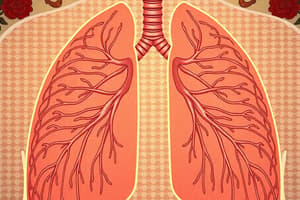Podcast
Questions and Answers
What does Positive End-Expiratory Pressure (PEEP) help prevent?
What does Positive End-Expiratory Pressure (PEEP) help prevent?
- Decrease in surface tension of the alveoli (correct)
- Elevated heart rate
- Reduced lung compliance
- Increased oxygenation in the blood
Why is PEEP used in critically ill patients?
Why is PEEP used in critically ill patients?
- To speed up the breathing rate
- To reduce the chances of lung collapse (correct)
- To increase heart function
- To decrease blood oxygen levels
What is a common effect of septic shock on the body?
What is a common effect of septic shock on the body?
- Increased oxygen saturation
- Improved lung function
- Decreased blood pressure (correct)
- Enhanced cardiac output
In a patient with septic shock, why might their blood pressure drop?
In a patient with septic shock, why might their blood pressure drop?
How does PEEP impact lung compliance?
How does PEEP impact lung compliance?
What is the primary goal of applying PEEP in ventilation therapy?
What is the primary goal of applying PEEP in ventilation therapy?
How does PEEP affect surfactant function in the lungs?
How does PEEP affect surfactant function in the lungs?
What can happen if a patient with septic shock does not receive sufficient oxygen supply?
What can happen if a patient with septic shock does not receive sufficient oxygen supply?




